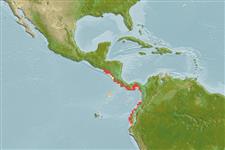Environment: milieu / climate zone / depth range / distribution range
Ökologie
seewasser; brackwasser; tiefenbereich 0 - 50 m (Ref. 189). Tropical; 14°N - 4°S, 89°W - 76°W (Ref. 189)
Eastern Pacific: El Salvador to Ecuador, perhaps south to northern Peru.
Size / Gewicht / Alter
Maturity: Lm ? range ? - ? cm
Max length : 7.7 cm SL Männchen/unbestimmt; (Ref. 189)
Rückenflossenstacheln (insgesamt) : 0; Afterflossenstacheln: 0; Afterflossenweichstrahlen: 16 - 22. Snout moderate, about 3/4 eye diameter; maxilla quite long, tip pointed, reaching almost to edge of gill cover; lower gill rakers increasing in larger fishes; pseudobranch long, extending onto inner face of operculum; gill cover canals of panamensis-type. Anal fin short, its origin under posterior third of dorsal fin base. Broad silver stripe along flank, lost with age.
Occurs in coastal waters. In the Gulf of Nicoya, Costa Rica, it is confined to the inner parts, thus apparently tolerating lowered salinities
Life cycle and mating behavior
Maturities | Fortpflanzung | Spawnings | Egg(s) | Fecundities | Larven
Spawn in school (Ref. 205).
Whitehead, P.J.P., G.J. Nelson and T. Wongratana, 1988. FAO Species Catalogue. Vol. 7. Clupeoid fishes of the world (Suborder Clupeoidei). An annotated and illustrated catalogue of the herrings, sardines, pilchards, sprats, shads, anchovies and wolf-herrings. FAO Fish. Synop. 125(7/2):305-579. Rome: FAO. (Ref. 189)
IUCN Rote Liste Status (Ref. 130435)
Bedrohung für Menschen
Harmless
Nutzung durch Menschen
Fischereien: kommerzielles potential
Tools
Zusatzinformationen
Download XML
Internet Quellen
Estimates based on models
Preferred temperature (Ref.
123201): 22.3 - 28.5, mean 27.1 °C (based on 32 cells).
Phylogenetic diversity index (Ref.
82804): PD
50 = 0.5000 [Uniqueness, from 0.5 = low to 2.0 = high].
Bayesian length-weight: a=0.00513 (0.00232 - 0.01135), b=3.14 (2.96 - 3.32), in cm total length, based on LWR estimates for this Genus-body shape (Ref.
93245).
Trophic level (Ref.
69278): 3.3 ±0.4 se; based on size and trophs of closest relatives
Widerstandsfähigkeit (Ref.
120179): hoch, Verdopplung der Population dauert weniger als 15 Monate. (Preliminary K or Fecundity.).
Fishing Vulnerability (Ref.
59153): Low vulnerability (10 of 100).
